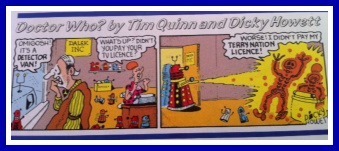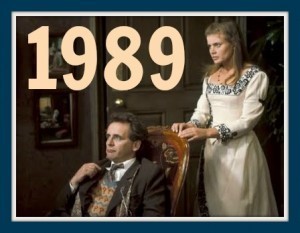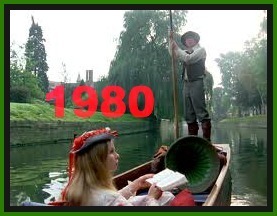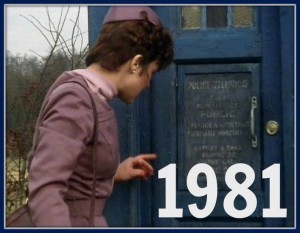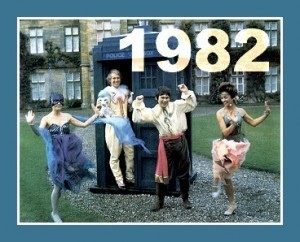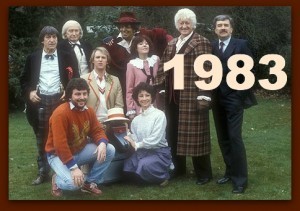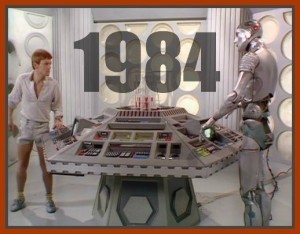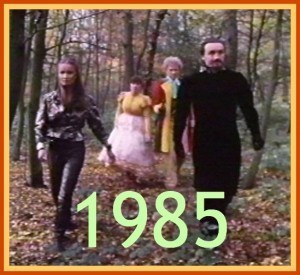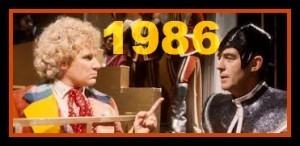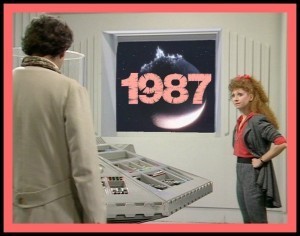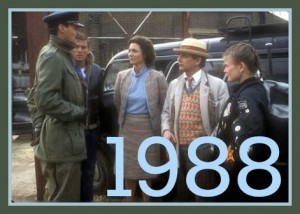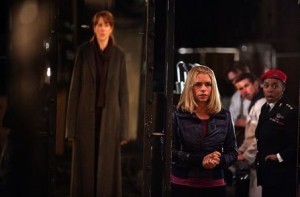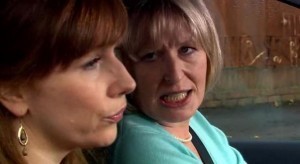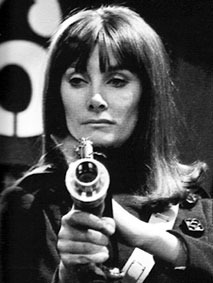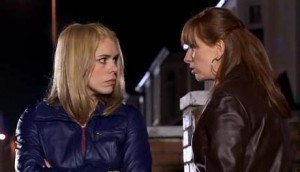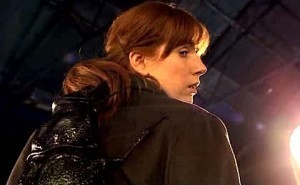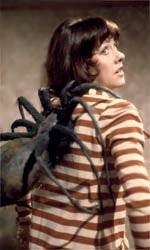Tansy Rayner Roberts's Blog, page 80
May 23, 2013
Friday Links Contains Small Parts
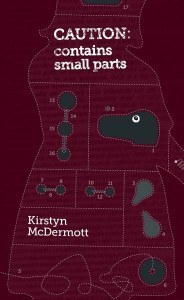 Kirstyn McDermott’s collection Caution: Contains Small Parts is about to become the new volume in the critically acclaimed Twelve Planets series – it will be launching at Continuum in a couple of weeks!
Kirstyn McDermott’s collection Caution: Contains Small Parts is about to become the new volume in the critically acclaimed Twelve Planets series – it will be launching at Continuum in a couple of weeks!
Meanwhile the very talented and hard-working Amanda Rainey, who is responsible for the gorgeous Twelve Planets covers, talks with David McDonald about how writers can get the best out of working with a cover designer.
Everyone’s talking about Kindle Worlds this week, the plan to monetise (some) fanfic for registered media properties. My thoughts: so… you’re going to offer fanfic authors the chance to make money off their product, but tell them what is and isn’t appropriate content, and control their intellectual property? Wow, that’s going to spark off some Internet smackdowns that will make the Harry/Hermione-Harry/Ginny wars look like gentle conversations. Fanfic is a heavily self-regulated community, and they have SYSTEMS, people. This is… well. It’s gonna be interesting.
The posts I’ve most enjoyed on this topic for their critical thoughts are those by Diana Peterfreund and the Angriest.
Kameron Hurley has written a spectacular essay about the portrayal of women in fiction as well as history, and how damaging and problematic narratives are sometimes the easiest to write even when you know better: We Have Always Fought: Challenging the Women, Cattle and Slaves Narrative.
Meanwhile Peter M Ball talks about King’s On Writing, and how the advice in the book can be damaging to writers. No such thing as universally good writing advice, people!
A cute & in-jokey comic about female comics creators as a superteam by the spectacular Amy Mebberson.
Worried about the Blake’s 7 Reboot? Check out this audio version, featuring Colin Salmon (a wonderful Avon!), a Scottish Servalan and Benedict Cumberbatch. I got quite addicted to these a few years ago, and glad they are getting a re-release thanks to teaming up with Big Finish. I wasn’t convinced by their casting of a new Vila or Jenna but they did make up for it by dragging back Michael Keating for the very cute ‘When Vila met Gan.’
I think the most comprehensive post on the Big Questions that arose from the final episode of the latest series of Doctor Who – plus some very entertaining macros of John Hurt.
May 22, 2013
Gender, Ambivalence & the Women of Westeros
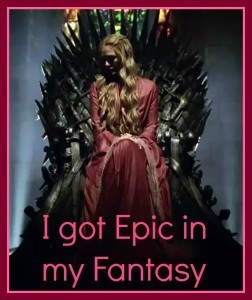 So, I have finally come to the end of my several-month-long quest that is the five books of the unfinished A Song of Ice and Fire saga, AKA A Game of Thrones The Books.
So, I have finally come to the end of my several-month-long quest that is the five books of the unfinished A Song of Ice and Fire saga, AKA A Game of Thrones The Books.
I’m not feeling the entitled outrage that GRRM hasn’t finished writing them yet, but I’m sure it’s gonna kick in any day now.
I’m still digesting it all, but wanted to start processing some of my thoughts about this series, its incredible popularity and acclaim (even before the TV series started, but way more now) and its role at the centre of so many discussions about what’s right and wrong with the fantasy genre when it comes to the representation of women, gender issues, and sexuality.
What intrigued me most, to tell you the truth, is that whenever the big discussion about female characters in epic fantasy fiction starts up again, ASOIAF (Game of Thrones is SUCH a better series title, just saying) is frequently cited on both sides of the argument – that is, as an example of a male writer writing a variety of female characters in a rich, nuanced and substantial way, AND a male author writing female characters in an extremely problematic way.
Looking at the books from the other side, I have to say – well, yep. Both those things are true.
ASOIAF is full of women, and does actively engage with issues to do with gender roles in sexist historical-ish societies. There is a lot more of this in the text than I had expected, and it happens across a variety of characters – we see, for instance, how vulnerable many women are from a legal standpoint in a patriarchal society, how little control they have as to some of the major decisions in their lives (like whom they get to marry) and the power they get to wield often depends a lot on how controlling the men in their lives choose to be. The widows can generally take the most freedom for granted, and get away with doing what they want compared to the daughters and wives – though the ones who do best at these are the ones who have the best manipulation skills, and/or luck in their male relatives.
All of this does reflect a general historical default, which was often true in many pre-industrial eras.
At the same time, the books also show many female characters rising above, challenging and railing against the limitations that the society of Westeros in particular (but some other cultures too, such as the Dothraki) place upon their women. Some of these characters succeed, and some fail. Just as some of the women who stay within their more traditional gender roles suffer for it, others thrive by making themselves exceptions – and some have more mixed results.
Almost as if women are real people. I know, right?
[If you don't want to be spoiled ALL the Game of Thrones books up to & including the end of A Dance With Dragons, plus occasional mentions of the TV series up to recent episodes, then please don't continue reading. Just be aware before you run away that there's a big fat BUT coming, & this isn't a puff piece about what an awesome feminist text this is. Truly not.
Also while I'm at it, MASSIVE TRIGGER WARNING for discussions of rape, body horror & torture. Which really should be taken as read with these books, but I don't want to surprise anyone.]
Add to this the fact that by Books 4 and 5, the female cast has expanded substantially, with more and more key female characters getting either regular or occasional point of view chapters. I’ve heard Book 4, Feast of Crows, disappointed many because the Tyrion and Daenerys storylines didn’t show up at all but OMG that book is wall to wall women – not only do Cersei and my beloved ugly knight Brienne become proper point of view characters, but let me introduce you to the freaking SAND SNAKES, a bunch of alarmingly dangerous bastard-born princesses in Dorne who win my vote for characters most in need of a spin off TV series when Game of Thrones has to pause for GRRM to catch up with his writing.
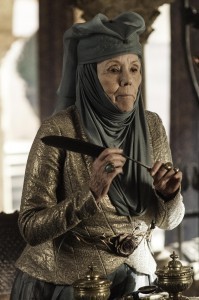 And as watchers of the TV show have undoubtedly also enjoyed, we also have the cutting, observing wit of the glorious I’m-elderly-and-have-nothing-to-lose Olenna Tyrell, the Queen of Thorns, who is every bit as marvellous in the books as she is in the TV show, though that could possibly be because I knew Diana Rigg was playing her when I got to that bit, and so read all the lovely snarky lines in her voice. Still, to have a character like this – an old, smart woman who has seen it all and has no respect for the dignity of the pompous men of younger generations – in an epic fantasy novel is extraordinary, as old women are often portrayed as invisible or petty/annoying if they look their age, and only get much play at all if they still look young and beautiful thanks to magic AKA Polgara the Sorceress – meanwhile, the decrepit, funny and wise old man is an epic fantasy staple.
And as watchers of the TV show have undoubtedly also enjoyed, we also have the cutting, observing wit of the glorious I’m-elderly-and-have-nothing-to-lose Olenna Tyrell, the Queen of Thorns, who is every bit as marvellous in the books as she is in the TV show, though that could possibly be because I knew Diana Rigg was playing her when I got to that bit, and so read all the lovely snarky lines in her voice. Still, to have a character like this – an old, smart woman who has seen it all and has no respect for the dignity of the pompous men of younger generations – in an epic fantasy novel is extraordinary, as old women are often portrayed as invisible or petty/annoying if they look their age, and only get much play at all if they still look young and beautiful thanks to magic AKA Polgara the Sorceress – meanwhile, the decrepit, funny and wise old man is an epic fantasy staple.
Ahem. But let’s not get ahead of ourselves here. Despite the many, many awesome things about this ridiculously readable million+ page fantasy epic by Mr Martin (I have fallen and I can’t get out), the books are also seriously problematic in many ways, especially from a gender standpoint.
There’s the creepy, sadistic violence, performed mostly against men when we’re talking about main characters, and mostly against women when it’s walk on, supporting characters or ‘extras.’ (though our female main characters are under almost constant threat of creepy, sadistic violence, or forced to witness the above which brings its own issues along to the party) There’s the psychological torture and familial abuse. There’s the distressing fact that one of the most otherwise likeable male characters in the story (Tyrion, a dwarf who allows the author to explore some fascinating issues to do with disability, power and ableism in a medieval world) is revealed retrospectively to have taken part in a violent gang rape against his first wife, after being manipulated by his father into thinking she was a prostitute who had faked her love for him, and that HE ONLY FEELS ESPECIALLY GUILTY ABOUT THIS AS ANYTHING OTHER THAN HIS OWN PERSONAL TRAGEDY after it’s revealed that this was in fact, another lie and she was “innocent.”
Yep, that’s Tyrion, our fan favourite character. Ouch.
Add to this the fact that, in response to learning about his brother’s betrayal and the “innocence” of his wife (inverted comments for this one because of the narrative’s general presumption that a woman being gang-raped is automatically less vile/horrific if she is a professional prostitute), Tyrion then goes to confront his father, discovers his recent former mistress in his father’s bed, strangles her with a gold chain, then murders his admittedly vile father.
Book 3 is, in case anyone is wondering, the most depressing book of the series, and I really don’t know how they’re going to depict that part in the TV series.
Oh and for those following along at home with my Galactic Suburbia updates – we ALMOST got to the end of the 5 book run without getting a rape scene from the point of view of either party, but then there was this utterly charming interlude in which Asha Greyjoy is raped by one of her military allies, only for it to be later revealed in the narrative that haha, tricked you, that was actually consensual sex as part of an ongoing relationship. So, yeah. There was that.
I do actually worry that the extreme rapeyness of these books (honestly, it’s wall to wall in some scenes) has actually desensitised me to the concept. As noted in a recent review of the TV series, you do get to the point where you find yourself thinking kindly of completely morally bankrupt characters for NOT taking the opportunity to rape young girls, which is… a really gross way of thinking about the world. For the most part, the use of rape as wallpaper to show what a harsh world this is for women becomes a kind of white noise in the soundtrack of the books.
And yes, main characters who are women are threatened with rape on a near-constant basis, while men almost never are – there are a few instances, but such a tiny number in comparison to the massive weight of female rape & rape threats that they are statistically insignificant. Physical humiliation and degradation are heaped on male characters, don’t get me wrong, but like most literature ever, A Song of Ice and Fire exists in a reality bubble where no one is willing to acknowledge how common male-male rape is in situations involving war, slavery and well, history.
[at this point, because I was thinking about double standards, I wrote a very long section about the gendered use of nudity in HBO's Game of Thrones, then cut it out to be a post on its own - so look out for that soon!]
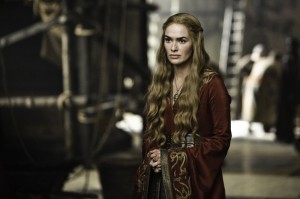 The most unpleasant scene from a gender point of view that I came across in my reading of the books is the Submission of Cersei in A Dance With Dragons. Of all the ASOIAF things I could be outraged about, this is the one that has left me with the greatest feeling of discomfort and the one I am least looking forward to seeing depicted on screen.
The most unpleasant scene from a gender point of view that I came across in my reading of the books is the Submission of Cersei in A Dance With Dragons. Of all the ASOIAF things I could be outraged about, this is the one that has left me with the greatest feeling of discomfort and the one I am least looking forward to seeing depicted on screen.
Which is odd, and possibly unfair. Because it follows the pattern established in this series which is a) almost everyone is morally grey as a default and gets more and more morally bankrupt as time goes on, b) the really horrible and or extremely annoying characters (plus a few random likeable ones, heh tricked you) either die in quite satisfyingly horrible ways, or go through such a prolongued period of suffering that you start to quite like them in what feels like a form of literary Stockholm Syndrome.
Exhibit A: Jaime Lannister, an utterly entitled prick who doesn’t love anyone but his sister (whom he loves so much they had three children together) and his ability to be the Best Swordsman Evah, imprisoned for a year, has his sword hand cut off, dragged through hell and back, actually starts to become a better person because of it, actually he’s kind of adorable now I SHIP HIM AND BRIENNE SO MUCH. Sure, he doesn’t love his children, and he tried to murder that 8 year old that time, but he’s witty and clever and AAAARGH THIS BOOK.
Ahem.
Exhibit B: Theon, an appallingly vicious little sod who betrays the family who raised him in the hopes of appeasing his own vile father (lot of vile fathers in this show), murders a couple of kids in order to convince people he’s killed the boys he thought of as brothers, and treats women like disposable rags. Is then tortured, mentally broken and (it is implied) castrated off screen, has become so miserable and degraded when we see him again that it’s hard to connect him to the previous character. So when he does something even vaguely heroic, frankly it’s like seeing a monster write a lovely poem about daisies.
Cersei, on the other hand, starts out utterly evil and malicious but gradually has her power base and reputation peeled away and peeled away, mostly by the men in her life letting her down. I love her as a villain early on in the story, because she’s freaking terrifying, and she’s probably the most outspoken feminist in the story. She gets softened, though – almost all the horrible things she is thought to have done in the first two books, turns out she only did some of them. I can’t hate her the way I hate, say, her evil son Joffrey, or her evil father Tywin, or a whole bunch of the random evil dudes in this story who are mostly played by Noah Taylor.
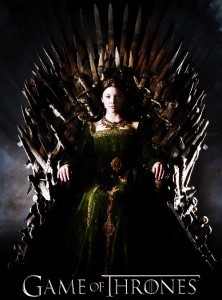 Cersei’s downfall comes due to Margaery Tyrell, the sweetness and light princess who marries each of her sons, and starts to dig away at Cersei’s power over them – not that, to be fair, she had nearly enough power over Joffrey. Finally, when Cersei puts the plan into place to frame Margaery for treasonous sexytimes (with a list of fake lovers stolen so blatantly from the Anne Boleyn playbook that the casting of Natalie Dormer in the TV show becomes hilariously extra awesome than it already was) Cersei is unexpectedly hoist on her own petard, and brought down to humbling depths by the religious order she herself empowered in the hopes they would be her own weapon.
Cersei’s downfall comes due to Margaery Tyrell, the sweetness and light princess who marries each of her sons, and starts to dig away at Cersei’s power over them – not that, to be fair, she had nearly enough power over Joffrey. Finally, when Cersei puts the plan into place to frame Margaery for treasonous sexytimes (with a list of fake lovers stolen so blatantly from the Anne Boleyn playbook that the casting of Natalie Dormer in the TV show becomes hilariously extra awesome than it already was) Cersei is unexpectedly hoist on her own petard, and brought down to humbling depths by the religious order she herself empowered in the hopes they would be her own weapon.
Imprisoned and at the mercy of others, she faces the loss of everything she has worked towards, and the betrayal of some pretty low-tier male characters who now decide to take over everything in her absence. Her only way to get back to her home and her son is to confess to a few saucy crimes, hope she gets away with being terribly sorry… and, oh, making a deeply raw, soul-damaging pilgrimage through the streets of her own city, stripped naked and penitent, in a long and painful scene that shows every stumble, every embarrassment and moment of rage, every vegetable thrown, every leering look. It’s grotesque in its fine detail, and while Cersei’s downfall was a) her own doing and b) largely orchestrated and implemented by other women, it feels distressingly gendered.
Jaime Lannister loses his hand and has to cope with being vulnerable in a way he has never been before, but his degradation does not feel as lovingly, cruelly dwelled upon as this. Theon’s degradation happened largely between his appearances in the books (and many, many viewers have railed against being shown this torture on the screen through Season 3 which goes to show that, you know, it’s not fun to watch people suffer at length).
Cersei suffers, I felt, at gratuitous length. And if the book had ended with a moment of triumph for her, I would have felt better – but instead, there is only one muted triumph, the revelation that a Certain Someone (gotta be a Clegane brother, right? Never saw either of their bodies) is still alive and therefore she is likely to survive her trial of arms. The second triumph, that is, the surprising double murder of the two men who have taken Cersei’s power in her absence, Sir Kevan Lannister and Old Julian Glover’s Beard, is satisfying if like me you felt Cersei was due a win, but actually…
No. The murder was done by the surprisingly returned Varys, still supporting a king who hasn’t quite turned up yet, and it was done not out of CERSEI’S RIGHTEOUS VENGEANCE but because the duo of Lannister and Gloverbeard was annoyingly competent, and he wanted to go back to the days when Cersei and her family were slowly destroying the kingdom to make it easier for his boy to stroll in and win.
UM. UM. UMMMMM.
So, yeah. I’m glad Cersei is in one piece heading into the Future Books, and that we get her POV scenes now, because she’s fascinating, but I am quite disappointed in her legacy apparently being an incompetent political leader because I loved the earlier narrative about how she was surpassing both her brothers in being her father’s true heir, and her father was an idiot for not seeing her strengths.
But maybe since everyone else is getting redemptive arcs, she’ll get one too? MAYBE?
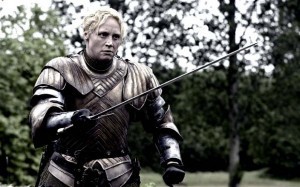 In the mean time – ASOIAF is hugely problematic in many, many ways, and yet it’s so damned readable, and it provides such rich and complicated female characters. I’m disappointed with the Cersei arc, and to some extent with the Retrospective Descent of Tyrion (note: his suffering quest, following the revelation about what he did to his wife, and the double murder of his father and mistress, involves having to sail around a lot, nearly dying a few times, and being enslaved as a comedy dwarf, but never ACTUALLY having to do anything more humiliating than riding a pig under a false name), but in the mean time we have Daenerys learning to be a queen and to ride dragons, Arya training as a sinister assassin, Margaery and her wicked aunt laughing at everyone, Brienne being the Best and MOST NOBLE and risking death because she’s too honourable to even pretend she will murder Jaime Lannister no matter who asks her, and DID I MENTION SAND SNAKES, and I have not yet given up hope that Sansa Freaking Stark is not going to tear out of her hiding place at the moment we least expect and get herself some Serious Vengeance!
In the mean time – ASOIAF is hugely problematic in many, many ways, and yet it’s so damned readable, and it provides such rich and complicated female characters. I’m disappointed with the Cersei arc, and to some extent with the Retrospective Descent of Tyrion (note: his suffering quest, following the revelation about what he did to his wife, and the double murder of his father and mistress, involves having to sail around a lot, nearly dying a few times, and being enslaved as a comedy dwarf, but never ACTUALLY having to do anything more humiliating than riding a pig under a false name), but in the mean time we have Daenerys learning to be a queen and to ride dragons, Arya training as a sinister assassin, Margaery and her wicked aunt laughing at everyone, Brienne being the Best and MOST NOBLE and risking death because she’s too honourable to even pretend she will murder Jaime Lannister no matter who asks her, and DID I MENTION SAND SNAKES, and I have not yet given up hope that Sansa Freaking Stark is not going to tear out of her hiding place at the moment we least expect and get herself some Serious Vengeance!
So, I’m conflicted. I think I’m now officially a fan of these books, but that doesn’t mean I don’t see the problems and failings in them – admittedly for me, the journey in teasing out these problematic aspects was a major enjoyment factor in reading the book, and ditto for watching the TV series – which I came to after a whole year of reading feminist commentary on all the yuck factors.
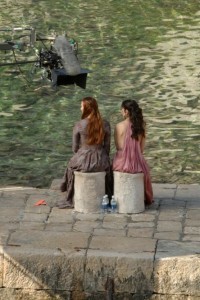
How to Be A Fan of Problematic Things indeed!
I’m really glad I read these books, not only because it gives me a more layered perspective on the TV show (I am crazy fascinated with the adaptation process of things generally, and whatever else Game of Thrones is, it’s an extraordinary achievement in adaptation) and because I enjoyed the hell out of reading them (except for the sitting up miserable watching miserable things happen to miserable people and oh my heart still breaks for Arya never being reunited with her mother, oh Catelyn Catelyn I knew you were doomed but not that you’d never know your sons had survived you!) but also because it is some pretty ferocious fuel for Thinking About Epic Fantasy which is something I want to devote a lot of time to this year.
And you know, I feel bad about liking the books so much. There’s a part of me that suspects I’ve lost feminist brownie points, even if I was the only one in charge of said points. Not for a long time have I accepted the charge of Guilty Pleasure so comprehensively.
So here is my redemptive arc, my pilgrimage of atonement – which I am certain will be far more constructive than the one GRRM inflicted on Cersei Lannister! I am going to spend a large portion of this year’s reading energy on more, more, more epic fantasy, but for the rest of 2013 I’m going to stick to epic fantasy written by women. I have Kate Elliott and NK Jemisin ready to go on my Kindle, I want to do a book-by-book reread of the Tamora Pierce Tortall series, and I plan to be hunting down some new-to-me writers, too. If this is the year of me re-embracing and re-immersing myself in a genre that has always meant a lot to me, let’s get some serious perspective on the matter, and start writing more analysis about the women in fantasy novels BY WOMEN.
Recommendations of epic fantasy would be greatly appreciated, though don’t think that I don’t already have a list as long as my arm.
The Best Excuse for Cake
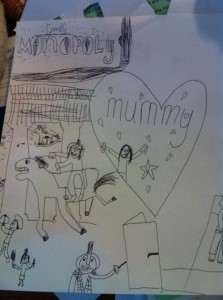 So it’s my 35th birthday! It was a pretty chilled out day. My presents so far have mostly included chocolate and tea which is most pleasing and appropriate, though I’ve also received a couple of rather lovely pieces of crockery for my new (super old) kitchen dresser: a gorgeous Persephone Books bowl featuring a pomegranate design from Alisa, and a TARDIS teapot from my honey.
So it’s my 35th birthday! It was a pretty chilled out day. My presents so far have mostly included chocolate and tea which is most pleasing and appropriate, though I’ve also received a couple of rather lovely pieces of crockery for my new (super old) kitchen dresser: a gorgeous Persephone Books bowl featuring a pomegranate design from Alisa, and a TARDIS teapot from my honey.
Raeli gave me a beautiful piece of artwork – a sketch depicting our family in the Trojan War, playing Sparkly Monopoly, napping together (that is, me and the girls piled on top of each other reading books while their Daddy naps deeply beside us which is ENTIRELY ACCURATE), and a family portrait of us as fairies.
Lunch, some actual reading time (shock!) and I also probably spent more time than I should have working on a post about A Song of Ice and Fire. I got a single lovely child free hour thanks to my honey taking Jem for a walk to buy CAKE.
Jem went through a slightly frantic and stressful (for me) art period in the afternoon – MUST MAKE ART MUMMY – which involved clue and paper curls and cutting random bits of paper and oh gah, artistic children. Lovely but also messy and inconvenient. I am proud of her love of art but there are times when I just want her to go watch some nice tidy television instead.
But the really cool thing is that before dinner, my whole family gathered together and watched all 5 episodes of The Mind Robber (1968) with me! I’d always thought that the ‘books and fairy tales’ theme of this story would make it a Classic Who my girls were likely to enjoy despite the whole black and white thing, and I was right! Not only my three-year-old Hartnell fan Jem watched rapt but after one episode of casually playing Minecraft while glancing up occasionally, Raeli was hooked too.
It helped a lot that Raeli’s on a massive Greek Myths kick at the moment, so the guest appearances of the Minotaur and Medusa were a delight to her. Jem was quite freaked out by Jamie losing his face and being played by a guest actor (we’ve all been there, love) but adored the White Robots, and decided Zoe was the best. Hard to argue with that.
I love The Mind Robber so much. For years it was the only Troughton story I watched and rewatched regularly so apart from The War Games, most Troughton Doctor Who baffles me a bit because it’s not quite enough like The Mind Robber. But no other Doctor Who ever is anything like The Mind Robber! It’s all word games and riddles, Rapunzel and Karkus and the lovely, lovely Lemuel Gulliver. Also it’s gorgeous to look at, one of the prettiest and most dramatically-designed of the black and white episodes. I love nearly every frame, and it made me ridiculously happy that it kept my children entertained for two hours today.
Dinner was, as most of the dinners have been lately, a delicious thing from the new slow cooker I requested for Mother’s Day – we had chicken mini-roast with leeks that had been cooked for EIGHT HOURS, omg, leeks should always be cooked that way. And cake, of course, because that’s what birthdays are for.
At bedtime, Jem started crying because she hadn’t wrapped a present for me, and she had really wanted to. I tried convincing her that actually the lovely time we spent together all day counted for more than presents, but she countered with I WANTED TO WRAP SOMETHING and really, there’s no arguing against that. Eventually Raeli took her away and they wrapped up a plush purple octopus that I have owned for years. Problem solved!
Now the children are asleep and it’s Elementary and designer chocolate from my mother, and blogging. A lovely day.
May 20, 2013
Galactic Suburbia 81
 In which we chew over shortlists, awards winners, book covers and gender issues, all of which pales in comparison to the FIRST QUILT IN SPACE.
In which we chew over shortlists, awards winners, book covers and gender issues, all of which pales in comparison to the FIRST QUILT IN SPACE.
Download or stream the episode here, or get it direct from iTunes.
Hugo Packet! What are YOU going to read? Would password protected freebie novels put you off reading them?
Campbell Memorial Award finalists
Comments: Tansy on “winning too many awards” & Keith Stevenson on why the awards are just fine and don’t need to be ‘sorted out’. To add some positivity (which more accurately reflects most people’s experience of this awards night!) check out Sean’s Storify of the AA’s night and Tehani’s post on attending at the last minute with lovely frockage pics. For even more gorgeous pictures, Cat Sparks’ Flickr feed is the way to go!
The coverflip experiment, started by Maureen Johnson’s piece on Huffington Post.
The artist behind the Georgette RR Martin cover discusses her imaginary brief.
Hawkeye Initiative Coda – using humour & art to get the gender point across in the workplace.
THE FIRST QUILT IN SPACE! Frontier craft for the final frontier.
Also, bye bye Commander Hadfield – thanks for bringing back the sense of wonder
The most significant futurists of the past 50 years
Tansy Melbourne public appearances to announce:
Sisters in Crime 14 June dinner & “in conversation with Livia Day, Josephine Pennicott & Poppy Gee”
Splendid Chaps 15 June – details tba, keep an eye on the Splendid Chaps website for booking details after the 23rd May.
Culture Consumed
ALISA: Star Trek Into Darkness
TANSY: Iron Man 3 FINISHED GAME OF THRONES BOOKS; Queers Dig Time Lords, 2 Minute Time Lord discussion with editors/contributors of QDTL
ALEX: Alanna, Tamora Pierce; The Thief, Megan Whalen Turner
Please send feedback to us at galacticsuburbia@gmail.com, follow us on Twitter at @galacticsuburbs, check out Galactic Suburbia Podcast on Facebook and don’t forget to leave a review on iTunes if you love us!
DWM Keeps the Faith in The Wilderness Year [WHO-50—1990]
 The 1990’s were an important era for me as a Doctor Who fan. They represent my teen and early adult years, when I was building on my fannish love.
The 1990’s were an important era for me as a Doctor Who fan. They represent my teen and early adult years, when I was building on my fannish love.
This decade – and in fact the entire period from 1990-2004 (with a brief holiday in 1996) is often referred to as ‘the Wilderness Years,’ coined by the team who worked on the eternal Doctor Who Magazine during this era and feel the need (quite rightfully) to point out their valiant efforts in maintaining a quality media tie in publication without a regular show to support. For more than a decade.
In truth, the 90’s were full of Doctor Who – just as the Target novelisations came to a natural end, the VHS releases of classic stories took off with a vengeance, bringing new audiences to old stories. The original series of adult New Adventures and Missing Adventures novels began in 1991 and produced an enormous quantity of stories over the next six years, only to be replaced by the similar-but-different BBC Book range of Eighth Doctor Adventures and Past Doctor Adventures which continued well into the new Millennium. There were comics and radio productions (okay not many, but some). Here in Australia we had even Doctor Who repeats on the ABC, often in the crazy early hours, which gave me the opportunity to see some Fifth and Sixth Doctor stories for the first time ever.
So yes, there was a lot happening with Doctor Who in this decade, but a lot of it hadn’t started yet in 1990. I freely admit that this at least was a Wilderness Year, though for many it wasn’t entirely clear that Doctor Who had in fact ended…
As it happens I have two 1990 issues of Doctor Who to hand and can give you the scoop on what (if anything) was going on with Doctor Who in the Wilderness Year. A time capsule into the past! (Cue wobbly wobbly flashback effect)
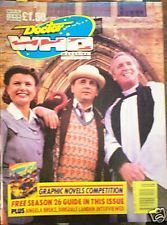 DOCTOR WHO MAGAZINE No. 159 £1.50
DOCTOR WHO MAGAZINE No. 159 £1.50
April 1990
Cover: a photograph of Sophie Aldred, Sylvester McCoy and Nicholas Parsons in costume for The Curse of Fenric.
Cover Text: GRAPHIC NOVELS COMPETITION/FREE SEASON 26 GUIDE IN THIS ISSUE/PLUS: ANGELA BRUCE, DINSDALE LANDEN INTERVIEWED.
Editor: John Freeman.
Editorial: A response to Worlds of the Imperium, a book by Keith Laumer featuring the idea of time parallels, and a theory that not all Doctor Who adventures take place in the same continuity.
Gallifrey Guardian:
BBC DILLY DALLIES.
No final decision had been made on the future of Doctor Who at the beginning of February. The BBC are still keeping all options open in finding a format that will take Doctor Who into the Nineties and keep it going for the next ten years. Head of BBC Drama Serials Peter Cregeen’s only new comment on the future was “There will be more changes than people think…” Something to ponder. If the programme remains in-house production may start as early as July this year…
BEYOND THE TARDIS:
Jon Pertwee provides voices for the thirteen part series of SuperTed which began on BBC1 on January 8th.
Tom Baker has been busy recently, completing an interactive video for children on road safety for the Department of Transport, in addition to recording Hyperworld with Douglas Adams for the BBC. He’s also co-presenting Boom! A new Channel 4 magazine format series from Ragdoll productions.
Peter Davison’s second series of Campion began on January 12th on BBC 1.
Louise Jameson’s final Bergerac appearance was in the season opener on January 14th, when she was murdered in A True Detective.
Video View:
With an announcement still awaited on the future of Doctor Who, the BBC have at least scheduled the release of more of the Time Lord’s stories on video. Las month An Unearthly Child, the first ever Doctor Who story, and The War Games, Partick Troughton’s final regular story as the Second Doctor went on sale. This brings the total number of stories available on tape to fourteen.
Interview with Angela Bruce from Battlefield:
DWM: The Brigadier first appeared in 1968, twenty-one years ago. Can you see yourself coming back in 21 years time and playing Brigadier Bambera?
ANGELA: I’d love to, it’s such a hoot, especially to be paid to have so much fun! It was very professional, though… When Ben (Aaronovitch) wrote the character he made it so she could come back like Nick’s Brigadier.
Comic Strip: Train Flight Episode One – Sarah Jane Smith meets the Seventh Doctor! (She insists they take the tube instead of the TARDIS to the jazz concert they want to attend, and of course the train itself ends up hurtling through a space vortex…)
Letters Column, YOU ON WHO – mostly this month responding to a previous issue reporting that Terry Nation and Gerry Davis (creators of the Daleks and Cybermen respectively) were bidding to bring back Doctor Who as an American co-production.
“They say they want to maintain the ‘British flavour… but add the pace and action of American TV drama’,” writes Nathan Cooke of Fairfield, Stockton-on-Tees. “What does this mean? MacGyver in space with British accents?”
“An Anglo-American co-production is the worse (sic) that could happen,” writes Matthew McLean from Basingstoke. “Worse than complete cancellation.”
But wait, there’s more!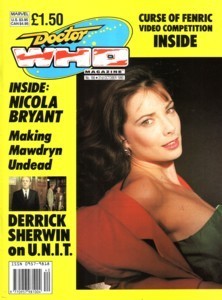 DOCTOR WHO MAGAZINE No. 166 £1.50
DOCTOR WHO MAGAZINE No. 166 £1.50
October 1990
Cover: a glamour shot of Nicola Bryant
Cover Text: INSIDE: NICOLA BRYANT/ Making Mawdryn Undead/DERRICK SHERWIN ON U.N.I.T./CURSE OF FENRIC VIDEO COMPETITION INSIDE
Editor: John Freeman.
Editorial: How exactly does the Master fund all of his Earth invasions?
Gallifrey Guardian:
GRAHAM WILLIAMS DIES
Former Doctor Who producer Graham Williams died in August, the result of an accident at home. Graham produced Doctor Who from 1976 to 1979 and is perhaps best known for the introduction of the Doctor’s mechanical companion, K9. However, he also produced the Key to Time Season, the first with an overall theme, which saw the first appearance of th Black and White Guardian. He cast both versions of Romana – Mary Tamm and Lalla Ward – and,most importantly, he secured the continuation of the programme in the face of fierce criticism at its levels of violence and horror.
PROGRAMME’S FUTURE STILL UNDECIDED.
As DWM went to press at the beginning of September, we learnt that four drama series have definitely been commissioned by the BBC for 1990 production. None of these are Doctor Who. If a decision was not announced in September, sources close to the programme said “Start worrying.” Sylvester McCoy, speaking at the TARDISin Durham convention, said he’d been told the programme made over five million pounds a year for the BBC. “If this is true, someone should tell the BBC accountants how much they’re losing by not making the show,” he added. Doctor Who Appreciation Society officials said a letter writing campaign would be considered if a decision was delayed still further.
The Doctor Who office officially closed on August 31st and John Nathan-Turner ended his tenure as Producer on the same day.
Controversy Corner: Richard Landen talks about the shocking inconsistencies of Doctor Who canon found in Target novelisations as opposed to the broadcast TV episodes, and tries to use logic to compare ‘regeneration’ vs. ‘rejuvenation.’
A Violent End: DWM tracked down Nicola Bryant to find out how she’s found life after Who. Very well, it seems…
Comic Strip: Fellow Travellers Part 3, scripted by Andrew Cartmel.
Letters Column, YOU ON WHO:
“I hope the BBC will consider bringing back old foes in Season Twenty-Seven,” says Peter Webber of Exeter.
Meanwhile, sixteen-year-old Tony Darbyshire of Wigan complains at the ‘Nostalgia’ articles in the magazine being ageist, as his Doctor Who memories start with City of Death and he can’t be expected to know anything about the Hartnell, Troughton or Pertwee years. Ahhh, fan entitlement, don’t ever change.
ELSEWHERE ON 1990:
Sorry, I got nothing.
PREVIOUSLY:
Or check out my overviews of WHO-50 posts on Doctor Who in the 1960′s, the 1970′s and 1980′s.
Meet Livia Day! (Sisters in Crime)
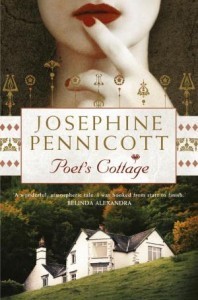 So, that crime-writing alter ego of mine has a pretty exciting weekend coming up in a few weeks. Those of you likely to be in Melbourne on 14th June, check out this awesome Sisters in Crime event!
So, that crime-writing alter ego of mine has a pretty exciting weekend coming up in a few weeks. Those of you likely to be in Melbourne on 14th June, check out this awesome Sisters in Crime event!
FRIDAY 14 JUNE – 8PM
SOMETHING ROTTEN IN THE APPLE ISLE
Three Tasmanian-born writers talk about their new novels
Josephine Pennicott, Poppy Gee and Livia Day have all set their novels in the Apple Isle, but with different and fatal twists. Presented by Lindy Cameron, a Sisters in Crime National Co-convenor and author.
Sydney-based Josephine Pennicott is the author of three fantasy books and now Poet’s Cottage (Pan MacMillan), a mystery novel set in a Tasmanian sea-fishing village in the 1930s and present day. It was sold in a bidding war to Ullstein publishers (Germany), along with Currawong Manor, her current mystery-in-progress.
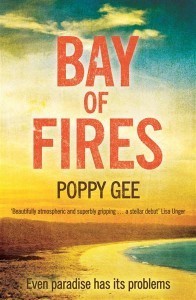 Poppy Gee, who was born in Launceston, spends every summer with her family at its shack in the Bay of Fires, also the title for her forthcoming debut novel (March, Hachette). The body of a backpacker washes ashore at the idyllic small town in Tasmania and the close-knit community starts to fall apart. As long-buried secrets start to come out, the delicate balance of their fragile lives is threatened. Poppy has nearly completed her next novel, another literary thriller set in the Tasmanian ski village Ben Lomond.
Poppy Gee, who was born in Launceston, spends every summer with her family at its shack in the Bay of Fires, also the title for her forthcoming debut novel (March, Hachette). The body of a backpacker washes ashore at the idyllic small town in Tasmania and the close-knit community starts to fall apart. As long-buried secrets start to come out, the delicate balance of their fragile lives is threatened. Poppy has nearly completed her next novel, another literary thriller set in the Tasmanian ski village Ben Lomond.
Livia Day has lived in Hobart for most of her life and A Trifle Dead (Deadlines/Twelfth Planet Press) is her first crime novel. The action revolves around Tabitha Darling who has always been a dab hand at pastry and a knack for getting into trouble – not a useful trait when she’s trying to run a hipster urban cafe?, invent the perfect trendy dessert, and stop feeding the many (oh so unfashionable) policemen in her life. It all goes pear-shaped when a dead muso is found in the flat upstairs. Livia fell in love with crime fiction at an early age.
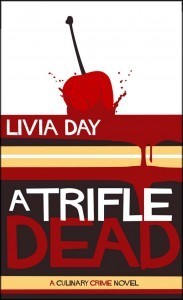 DETAILS …
DETAILS …
Venue: The Rising Sun Hotel (upstairs – no lift, cnr Raglan Street and Eastern Road South Melbourne)
Dinner: upstairs from 6.30pm (no need to book)
Men or ‘brothers-in-law’ welcome
Sun Bookshop stall: members get 10% discount
Melways: map 57H2
Trams: 1, 55, 112 or St Kilda Road trams
Parking: free on-street parking after 6pm
May 18, 2013
2012 Aurealis Awards (and having “too many” wins)
For the last couple of years I have attended the Sydney-hosted Aurealis Awards weekend, which is always a blast. Sadly I was reining back on travel this year and couldn’t make it – but it sounds like those who were there had a great time! Check in on the #AurealisAwards hashtag on Twitter to see some of the commentary on the night from those who were there. Sean the Blogonaut also Storified the event which provides the highlights in Tweets and Twitpicks.
Some great results here, and congratulations to all the winners! Special congratulations to Margo Lanagan who had a great night, taking out four awards (each chosen by separate juries!) for Sea Hearts, “Bajazzle” and “Significant Dust.”
I have to say, I found it pretty tiring that so many people (including tons that I love and respect) started trotting out the jokes so early about Margo winning so many awards, or as the jokes implied, TOO many awards. (Note: the jokes started before her first win) It reminds me of the recent commentary about Hilary Mantel in the UK winning “all” the awards and not leaving any for anything else. The jokes might all have been intended as good-natured joshing, but it’s a disappointing aspect of Australian culture in particular that there is such a low ceiling to people (even friends) celebrating your success, before they turn around and start suggesting (in jest or otherwise) that it’s something you should be ashamed of.
Chances are pretty high that Margo found it as funny as anyone else there last night, but as an onlooker on the proceedings the sheer weight and number of those jokes flying thick and fast across Twitter did make me a bit uncomfortable.
Sometimes, as I tweeted last night, an author has a really spectacular year, and awards reflect that. Margo Lanagan is one of our best authors, who happens to have put out a fantastic novel AND a brilliant original collection in the same year, and I know she wasn’t taking those wins for granted.
Margo is aces & I love her as a person as well as for her writing, and I doubt very much she will ever have a night where she goes home with four trophies again, so let her enjoy it, eh?
This might be a good time to link to the article that reworks Helen Garner’s speech for the Stella Prize recently – about how awards can mess with your head as a writer, regardless of whether you win or don’t win.
And now, the Aurealis Award winners! A great range of works being honoured here, very much worthy of a ‘To Read’ list. Too many of the winners are my actual friends so I’ll just say congratulations to EVERYONE. Worth noting that there’s quite a spread of publishers being covered here, from old hands HarperCollins and Allen&Unwin to new kids on the block digital-only publisher Xoum and some Aussies published overseas with NightShade and Clarkesworld. Twelfth Planet Press flew the flag for Australian indie presses with three short stories honoured from two Twelve Planets collections, Through Splintered Walls by Kaaron Warren and Cracklescape by Margo Lanagan. There was even a self-published winner with KJ Bishop’s collection – so, variety!
Check out the shortlist for some other amazing works.
CHILDREN’S FICTION (told primarily through words)
Brotherband: The Hunters by John Flanagan (Random House Australia)
CHILDREN’S FICTION (told primarily through pictures)
Little Elephants by Graeme Base (author and illustrator) (Viking Penguin)
YOUNG ADULT SHORT STORY
“The Wisdom of the Ants” by Thoraiya Dyer (Clarkesworld)
YOUNG ADULT NOVEL (tie)
Dead, Actually by Kaz Delaney (Allen & Unwin)
Sea Hearts by Margo Lanagan (Allen & Unwin)
ILLUSTRATED BOOK / GRAPHIC NOVEL
Blue by Pat Grant (author and illustrator) (Top Shelf Comix)
COLLECTION
That Book Your Mad Ancestor Wrote by K. J. Bishop (self-published)
ANTHOLOGY
The Best Science Fiction & Fantasy of the Year Volume 6 edited by Jonathan Strahan (Night Shade Books)
HORROR SHORT STORY
“Sky” by Kaaron Warren (Through Splintered Walls, Twelfth Planet Press)
HORROR NOVEL
Perfections by Kirstyn McDermott (Xoum)
FANTASY SHORT STORY
“Bajazzle” by Margo Lanagan (Cracklescape, Twelfth Planet Press)
FANTASY NOVEL
Sea Hearts by Margo Lanagan (Allen & Unwin)
SCIENCE FICTION SHORT STORY
“Significant Dust” by Margo Lanagan (Cracklescape, Twelfth Planet Press)
SCIENCE FICTION NOVEL
The Rook by Daniel O’Malley (Harper Collins)
PETER MCNAMARA CONVENOR’S AWARD
Kate Eltham
KRIS HEMBURY ENCOURAGEMENT AWARD
Laura Goodin
May 17, 2013
WHO-50 – The 80′s
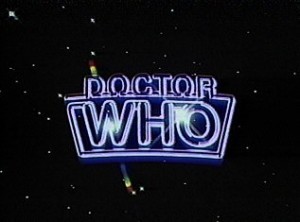 Another decade down, and that means it’s time for another WHO-50 round up!
Another decade down, and that means it’s time for another WHO-50 round up!
The Eighties was a turbulent time in Doctor Who, beginning with the cancellation of the part-filmed Shada, and ending with the hiatus and final “rest” of the show beloved by so many. The showman sensibilities of producer John Nathan-Turner meant some fantastic guest stars and overseas filming, and script editors Christopher Bidmead (science should not be silly), Eric Saward (if you’re going to have violent stories, let’s make them PROPERLY violent) and Andrew Cartmel (let’s show you just how sneaky and manipulative the Doctor has to be to save the universe) put their stamp on the show, as did the three actors who came in to play the Doctor in the wake of the iconic Tom Baker: Peter Davison, Colin Baker, and Sylvester McCoy.
The Master turned up, and up, and up again, looking suspiciously like the last Master despite being played now by Anthony Ainley. Monsters came and went, and alien planets started to look like more than just the occasional quarry, thanks to some cheeky new special effects. Now they looked like pink
Companions came and went, too – mouthy Tegan the flight attendant wandered on board the TARDIS along with brainy space princess Nyssa and brainy-but-dense mathematical genius Adric. She then spent a year trying to get back to her job at Heathrow Airport only to find out it wasn’t what she was hoping for – but that was a better fate than that of Adric, who perished in a pointless task, far from home. Later, sinister schoolboy-in-exile Turlough joined the Doctor and Tegan after only a few half-hearted attempts on the Doctor’s life, and they were briefly joined by Kamelion the shape-changing robot – if you blinked, you missed him.
Peri Brown replaced Turlough in the Doctor’s life, wearing a succession of tiny outfits as the lovely ‘sweet’ Doctor vanished unexpectedly, to be replaced with a bombastic bully who made her life mostly miserable – though she rallied above the verbal abuse to sling it back at him, and was eventually allowed to wear grown up clothes as the Doctor and the show were both put on trial…
Computer programmer and gym bunny Mel Bush turned up just in time to bring a lighter touch to the show, even if the showrunner seemed to value her mostly for her ability to scream in the same key as the musical sting that heralded the closing credits. And finally we had Ace, an entirely alien version of what teenage girls were actually like in the 1980′s… but adorably enthusiastic not only about adventures with the Doctor but also about blowing shit up.
They walked off into the sunset as the show came to an end… but oh, it wasn’t an end at all. The new beginning, away from the small screen, was just around the corner…
For more WHO-50 goodness, check out The Seventies and The Sixties.
May 16, 2013
Friday Links is Dressed as Amelia Earhart
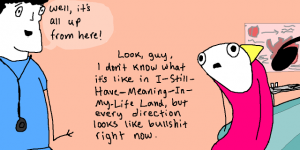 Probably the most important blog post I read in the last week is the update from the long-missed Hyperbole and a Half about her depression. As ever, she slices through the hard and complicated issues with a sharp, dissecting knife, using humour and clever artwork to communicate something of deep value and significance. While I am sure that many who suffer from depression will find something powerful in this post, I think it may have particular relevance to those who never have felt the symptoms of clinical depression, and despite their best intentions have trouble understanding how it FEELS.
Probably the most important blog post I read in the last week is the update from the long-missed Hyperbole and a Half about her depression. As ever, she slices through the hard and complicated issues with a sharp, dissecting knife, using humour and clever artwork to communicate something of deep value and significance. While I am sure that many who suffer from depression will find something powerful in this post, I think it may have particular relevance to those who never have felt the symptoms of clinical depression, and despite their best intentions have trouble understanding how it FEELS.
I have a horrible feeling that I have been, more than once, that gabbling friend trying to give helpful advice about a thing I know nothing about – and this post brought home exactly how little I know about this particular type of mental illness despite having many friends who have suffered from it in their lives. As with all great writing, this piece made me think differently about myself and the universe. Also, it’s horribly hilarious. Highly recommended, and I’m so glad to see H&aH back.
This sweet story is about a mother who decided to go beyond the ‘princess’ motif for her daughter’s fifth birthday commemorative photo, and dressed her up as a selection of feminist historical heroines.
A nice coda to the Hawkeye Initiative – how the genderflipping art project inspired an employee at a gaming company to take a stand and communicate a problem to her boss in a creative, classy way.
How Muriel Spark Saved Mary Shelley – the fascinating story of how “the canon” of literature really can be changed. Because, you know, it’s all about perception of value.
Nev Fountain, one of my favourite writers of Big Finish Audios, dissects The Doctor Who Historical as a sub-genre – what makes them great fun, and how to take apart their traditions when writing them. If you haven’t listened to his take on the Richard III mythology in The Kingmaker, you’re missing out.
Actor Gemma Arteton, whose mother sounds pretty hardcore awesome, talks about her current film projects, and particularly the female writers and directors she is currently working with. A smart lady! I love hearing stories about the women in today’s entertainment industry taking control of their careers and demanding higher standards in order to produce better, more interesting work.
Speaking of women in the entertainment industry taking control, The Hathor Legacy looks at some of the commentary surrounding Angelina Jolie’s decision to have a preventative mastectomy, and the appalling attitudes expressed by people who simply can’t comprehend the idea that a woman might be able to make an intelligent decision about her own future health, regardless of how complete strangers feel about her breasts. Jolie’s original piece, tellingly titled “My Medical Choice” is definitely worth reading in full, if only because it is so thorough and educational.
“My chances of developing breast cancer have dropped from 87 percent to under 5 percent. I can tell my children that they don’t need to fear they will lose me to breast cancer.”
The Women Aren’t Funny series of posts at Bitch Magazine continue to be entertaining and interesting – the latest one is about How Women-Only Spaces Break Up The Boys Club.
The Jane Dough presents: What Alanna of Trebond taught me about my career. Ohhh, I feel a Tamora Pierce reread coming on…
The Angriest presents some very pretty statistics about Doctor Who’s viewing figures since 2005. They have been remarkably steady! Stop panicking, you guys.
Watching New Who: Turn Left
David is coming to New Who for the first time, having loved Classic Who as a kid. Tehani is a recent convert, and ploughed through Series 1 to 6 (so far) in just a few weeks after becoming addicted thanks to Matt Smith – she’s rewatching to keep up with David! Tansy is the expert in the “Doctor Who in Conversation” team, with a history in Doctor Who fandom that goes WAY back, and a passion for Doctor Who that inspires us all. We are working our way through New Who, using season openers and closers, and Hugo shortlisted episodes, and sometimes a couple of extra episodes we love as our blogging points. Just for fun!
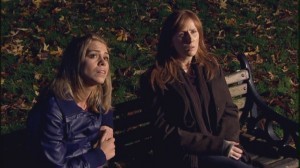 “Turn Left”
“Turn Left”
Series 4, Episode 11
THE DOCTOR – David Tennant
DONNA – Catherine Tate
ROSE – Billie Piper
WILF – Bernard Cribbins
SYLVIA – Jacqueline King
TEHANI:
So here we are at “Turn Left”, the only other Hugo nominated episode from this season, which I think is a bit sad because the Doctor/Donna season is one of my favourites. We just passed “Midnight”, which despite being Donna-lite, is really rather exceptional, I thought. Certainly one of the creepier episodes, with a good hard look at human nature (and, weirdly, it reminds me of how reality tv shows work, when they shove a bunch of strangers into a small space and see what happens). Lesley Sharp as Sky Silvestry is really quite marvellous, doing some incredible dialogue with Tennant. And of course we get a bonus fandom points with Colin Morgan (Merlin) as Jethro and David Troughton (yes, Patrick Troughton’s son!) as Professor Hobbes.
TANSY:
I think that “Midnight” was definitely worth a nomination, though possibly not at the expense of the two stories picked – what, we couldn’t get our usual three spots for the Hugo Ballot?? I also think it’s RTD writing at his best. It feels like that is the one where he is trying least hard to impress us all with showiness and grandeur, and the small scale of the production combined with bang-up performances and script was really very effective. Seeing Merlin with cool hair is quite personally distressing to me.
DAVID:
It’s definitely a strong ending to the season! Was RTD (Russell T Davies) still the showrunner at this point, or did he have more editorial constraints? “Midnight” was a wonderfully claustrophobic episode, with some excellent performances, though I thought that the speed with which they turned on Sky was a little convenient. I was a little in awe of Lesley Sharp’s performance, that dialogue must have been terribly difficult!
TANSY:
He was still the showrunner – and I’m glad he chose now to remind everyone that he is in fact a kick ass, world class scriptwriter. Sometimes.
As “Midnight” was Donna-lite, “Turn Left” is Doctor-lite, which I think is really interesting – the same as “Blink” made the Hugo-voters take notice, another fairly Tennant-less episode made the grade here (although unlike “Blink”, it didn’t get the gong that year, losing to Doctor Horrible’s Sing-Along Blog). But I wonder how much of the vote was for Catherine Tate’s fabulous portrayal of Donna, and how much was for the fact of Rose? I want to hope it was for Donna, but you never know.
TANSY:
I don’t think it’s necessarily the lack of Tennant that made this episode or indeed “Blink” particularly good, but the ones that Hugo nominators tend to notice are often those that break the mould or formula in some way.
Xena is the only other show I watched obsessively that had a similarly small ensemble (two main characters, rotating but no other regular support characters) and therefore had to do Protagonist-Lite episodes, both for Xena and Gabrielle. And while they often had brilliant material together, it was when one of them was gone that the scriptwriters really had to pull out all the stops because so much of their regular toolbox (and the reliable chemistry between the two actors) was missing. I could easily assemble a list of more than a dozen wonderful episodes of Xena which only featured one of the main leads, and it doesn’t surprise me at all that the episodes lacking the Doctor, the companion or both of them tend to be exceptional or at least very memorable.
I do think that it is very possible to tell a story entirely about the Doctor without showing him on screen, and that’s very much what we’re getting here. The story is absolutely a showcase for Catherine Tate, and one in the eye for anyone who thought she couldn’t cut it as a dramatic actress, but it’s also a story of a world without the Doctor, and what that might look like.
Catherine Tate is simply amazing in this. She is such a natural comedian that I think it can be easy to overlook her dramatic skills, but here she has a chance to show us what she is really made of, and hits it out of the park. The way that RTD explores her family dynamics provides some genuinely moving moments, and gives us a real insight into how her and her mother interact, in particular. Though, Bernard Cribbins is his usual excellent self!
TANSY:
Sylvia is marvellous too – some great character growth for all of them. And I think it’s really essential to look at this family and see how they cope with horrible, life-changing circumstances without a bloke in his magic box – they’re not fine but they are surviving and all of them pull together. Wilf’s wartime spirit and Sylvia’s slow acceptance of their situation are both conveyed very well and most of all we see how resilient Donna is.
DAVID:
In this Doctor Who version of It’s a Wonderful Life, we get a convincing alternate world and see just how much impact the Doctor has in even that short period of time. I really liked how we see that there are people who still step up to try and save the world, but that the cost is so much higher without the Doctor there. But, as much as we see the importance of the Doctor, it’s even more fascinating to see how important Donna is. Right throughout Doctor Who the companions make much more difference than they realise, they aren’t just hangers on or a support act to the Doctor, and this is a great example of why.
Okay, so I know I’m not the best judge of this, but I DO listen when other people discuss this stuff – am I right in thinking that New Who does this FAR better than Classic Who did? The companions are almost always shown to be really important, whether they actively save the day, or are just the moral compass that is there with the Doctor. And I don’t think this was as evident in Classic Who.
TANSY:
While I am an active defender of the companions of Classic Who, it’s true that the narrative of the show rarely gave them the kind of agency we get in New Who – while there were companions who were allowed actual growth and change through their run, you often get the impression that when it happened it was half accidental and half down to the actor in question portraying that despite the scripts. Very few of them got a) consistent, detailed backstory, b) family and friends back home, c) a coherent story arc or d) a leaving story worthy of them, and certainly few of them got more than one or two of those elements.
Even Ace, who was the last proper companion of Classic Who and is often held up as a forerunner to Rose (in all but the romantic aspect) was not given the same ‘protagonist here, coming through’ central role that Billie Piper’s character and her successors had.
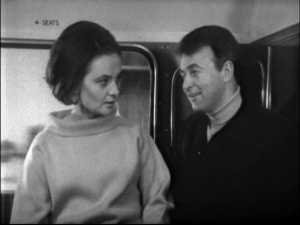 Having said all that, one of the best examples of character development and the companions driving the plot comes with Ian and Barbara at the very beginning of the show, so you could argue that New Who is building upon something that was an essential element of the original 1960’s Doctor Who. At least, I would argue that!
Having said all that, one of the best examples of character development and the companions driving the plot comes with Ian and Barbara at the very beginning of the show, so you could argue that New Who is building upon something that was an essential element of the original 1960’s Doctor Who. At least, I would argue that!
RTD’s era of the show certainly pushes the idea that being around the Doctor turns ordinary people into heroes, but “Turn Left” goes one better by showing they can do that without him, too.
DAVID:
I largely agree with Tansy’s argument here, however I think you can point to a number of examples of how being around the Doctor pushed some of the Classic Companions into far more heroic roles. Romana played a major part in many of her stories, though it could be argued that she developed more in the tie in novels, as did Sarah Jane who, as we know, went off to be the star of her own show. And of course, Adric died saving the Earth (I think he is a vastly underrated companion, and one of the reasons I was disappointed that they didn’t persevere with Adam Mitchell).
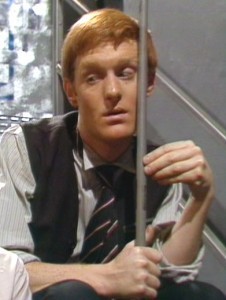 Funnily enough, when it comes to one of the characters given the most interesting backstory you can hardly claim that it was intended all along – I am sure that Turlough’s revelations were written on the fly! [Tansy wrote a great article about this.]
Funnily enough, when it comes to one of the characters given the most interesting backstory you can hardly claim that it was intended all along – I am sure that Turlough’s revelations were written on the fly! [Tansy wrote a great article about this.]
But, it was far from the deliberate writing of arcs that we saw in New Who, which probably has as much to do with the changing nature of television as Doctor Who itself. The fact that you have to search for those examples, and that they are far less involved than almost every companion in New Who backs up Tansy’s argument.
The big thing with Classic Who was the secondary character dying a noble death. It was pretty much a given, if you started to like one of the supporting acts or there was a complex, interesting character, their days were numbered and they would likely die in the last ditch effort to foil whatever end of the world event was in progress.
I much preferred this Rose. She has such a great sense of purpose, and helps set up the finale so very well. There is an ominous feel to her appearances, especially when she says “I am so sorry”, always a scary thing to hear in Doctor Who! And the scene at the end with the “Bad Wolf” stuff – spectacular!
I actually really like Rose’s return in this season too, especially in this episode. The fact that she is there instead of the Doctor to point the way for Donna is pretty exceptional, and I like how tough and competent she is now. She’s all grown up!
It’s also quite nice to see her being awesome even when the Doctor isn’t around – there’s a kind of double theme going on with the various returns of companions in this season, which is that 1) the companions do much of their “levelling up” after parting company with the Doctor and 2) he doesn’t always like what they turn into when he’s not around to influence them. In this case Rose doesn’t meet the Doctor at all, so we don’t have to deal with that second part of it.
TEHANI:
I definitely liked Rose better in this than I did in her actual run. Possibly it’s actually due (in part at least) to an improvement in Billie Piper’s acting *ducks for cover* but I think it’s mostly because she’s a proactive player in the story, and I liked that.
DAVID:
That’s it, isn’t it? These are the companions who have left the nest and gone out on their own, who have grown up. And, like any parent, sometimes the Doctor struggles with the idea that they aren’t his “children” anymore!
What did we think about the back bug thing? I’m still not sure I completely understand how that one works – do I need to employ hand-wavery?
TANSY:
I loved the concept – not only did the creepy ‘something on your back’ remind me of the Spiders, my favourite Classic Who monster, but I think it’s also quite clever – basically a time parasite that also works as a fairy tale concept? So it allows/forces a person to make a different life choice back in their timeline, and feeds on the resulting energy, which makes it similar to the Weeping Angels, actually.
I found the parasite very creepy! I remember walking through a web in the dark once and not realising for quite awhile that I now had a passenger in the form of a massive orb spider on my back. So, a bit too close to home. *shudder*
It was probably a bit more effective when we only saw glimpses, but lots of monsters are like that. I do agree, the concept of a time parasite is quite clever. I’ve always enjoyed the idea of time having its own ecosystem and would love to see it explored a bit more. We had the Chronovores in Classic Who, and I am trying to think of a few more examples – I am sure there must be!
TANSY:
There were the Reapers in “Father’s Day” that turned up to ‘sterilise the wound in time’ – but my favourite example of this is the vortisaurs in Big Finish – like time pterodactyls that live in the time vortex! But I agree, this is a great idea that perhaps has a lot more potential to be re-used in the future. The Doctor may be ‘Time’s Champion’ but you can see how anyone with a greater understanding to time might see him as more of a vandal and saboteur…
TEHANI
Ooh, and Tansy, MARKETPLACE! That’s what I kept thinking of when the Verity! podcast team were discussing “The Rings of Akhaten” a few weeks ago! (sorry David, no other talking about things you haven’t seen yet!)
Yes, this is the closest thing we get to a space marketplace before that episode we’re not going to discuss – though as I recall it caused a few eyebrows to go up because of the racial stereotyping. On the one hand it’s quite nice to arrive on a planet which isn’t defaulting to white or Anglo culture, on the other hand it does feel a touch like wandering through a pantomime of Aladdin. (we totally went to a small town pantomime of Aladdin the Christmas before last and omg it was DEEPLY uncomfortable, I was squirming as I watched a bunch of white Aussie kids in yellowface making chop suey jokes and all I could think over and over again was “I am so glad the internet is not in this audience”.)
At least they did cast actual Asian actors. So there’s that. And the marketplace is a tiny, discrete bit of this episode, so you can (I think) enjoy the story regardless. The actual performance of Tennant and Tate wandering through the space market is pretty awesome, though it’s not my FAVOURITE market wandering scene in this season which is of course back in “The Fires of Pompeii”.
DAVID:
I am afraid I am going to put my name down in the unimpressed camp here. I remember when I watched it wondering if there was any sort of controversy over it, because I found it very stereotypical. Not so much the market itself, but the scenes inside the tent seemed very heavy handed to me. Not “The Talons of Weng-Chiang” bad, though, but hopefully we are setting a higher bar than that!
TANSY:
Yep sadly ‘slightly less racist than “The Talons of Weng-Chiang”’ is not something anyone would want on their CV.
TANSYEDIT: To be completely fair, the show also makes some important commentary on racism in this episode, with the appalling treatment of immigrants in time of national crisis, and the scene where the lovable Italians they share a house with are taken off to ‘work camps’ which is pretty damned chilling.
DAVID:
Overall, though, I think RTD has delivered a stand out episode here, and one that sets us up for a stunning finale…
TEHANI:
I think you’re right – loved the focus on Donna, really enjoyed Rose this time around, and yes, “stunning” (in all its connotations) is one word for what comes next…
PREVIOUS “New Who In Conversations”
“Rose”, S01E01
“Dalek”, S01E06
“Father’s Day, S01E08
“The Empty Child/The Doctor Dances”, S01E09/10
“Bad Wolf/The Parting of the Ways”, S01E12/13
Season One Report Card – David, Tansy, Tehani
“The Christmas Invasion,” 2005 Christmas special
“New Earth”, S02E01
“School Reunion,” S02E03
“The Girl in the Fireplace”, S02E04
“Rise of the Cybermen/Age of Steel”, S02E05/06
Army of Ghosts/Doomsday, S02E12/13
Season Two Report Cards: David, Tehani, Tansy
“The Runaway Bride”, 2006 Christmas Special
“Smith and Jones”, S03E01
The Shakespeare Code & Gridlock, S0302-03
Human Nature/The Family of Blood S0308-09
Blink S0310
Utopia / The Sound of Drums / Last of the Timelords S0311-13
“Voyage of the Damned,” 2007 Christmas Special
Season 3 Report Cards: David, Tehani, Tansy
Partners in Crime, S0401
The Sontaran Stratagem/The Poison Sky, S0405 S0406
Silence in the Library/Forest of the Dead, S0408 S0409

